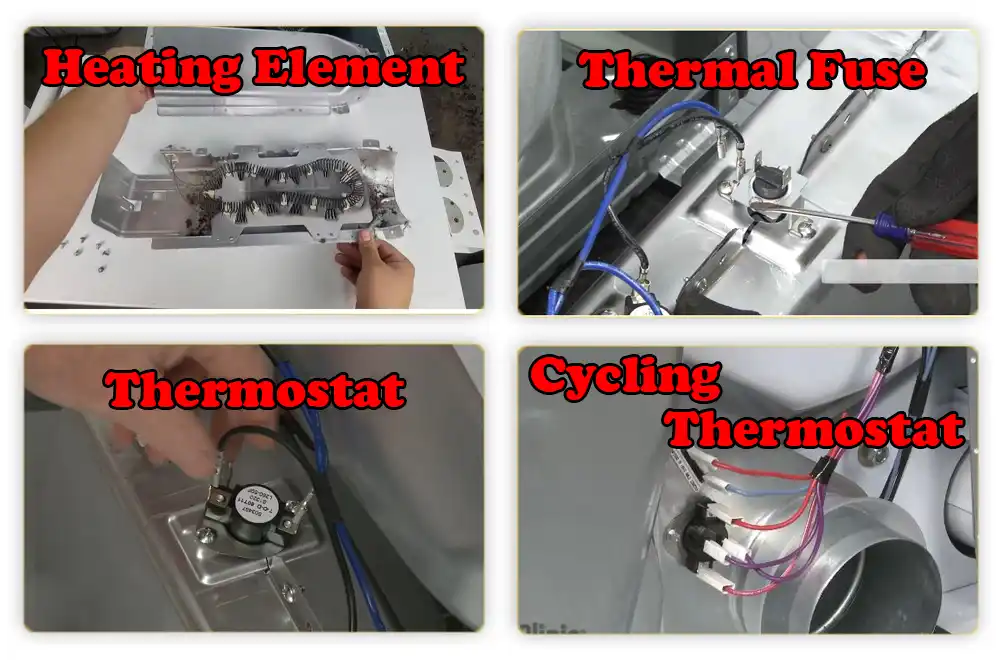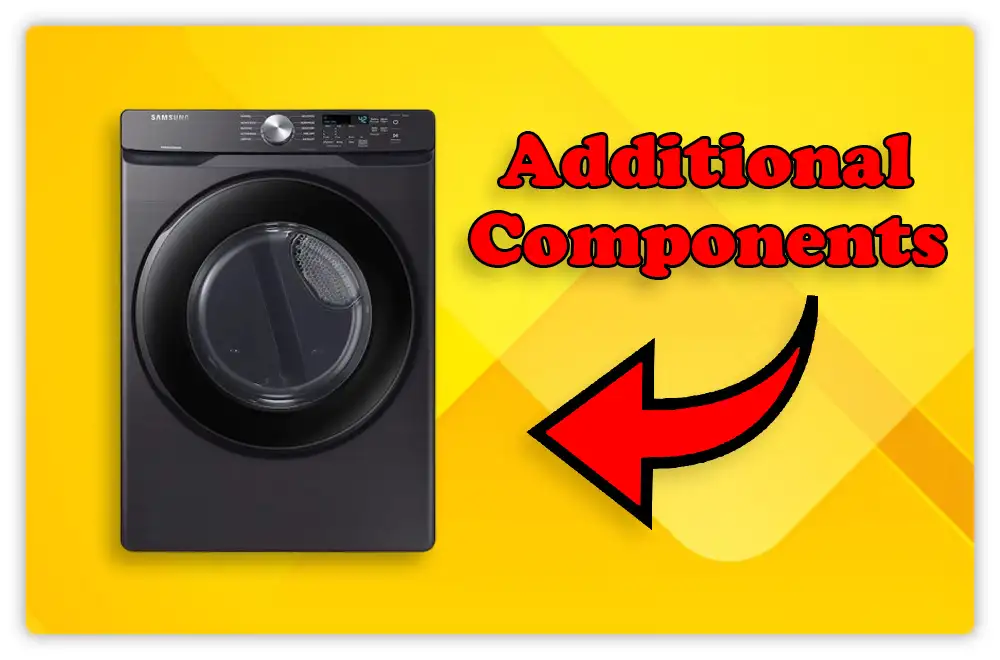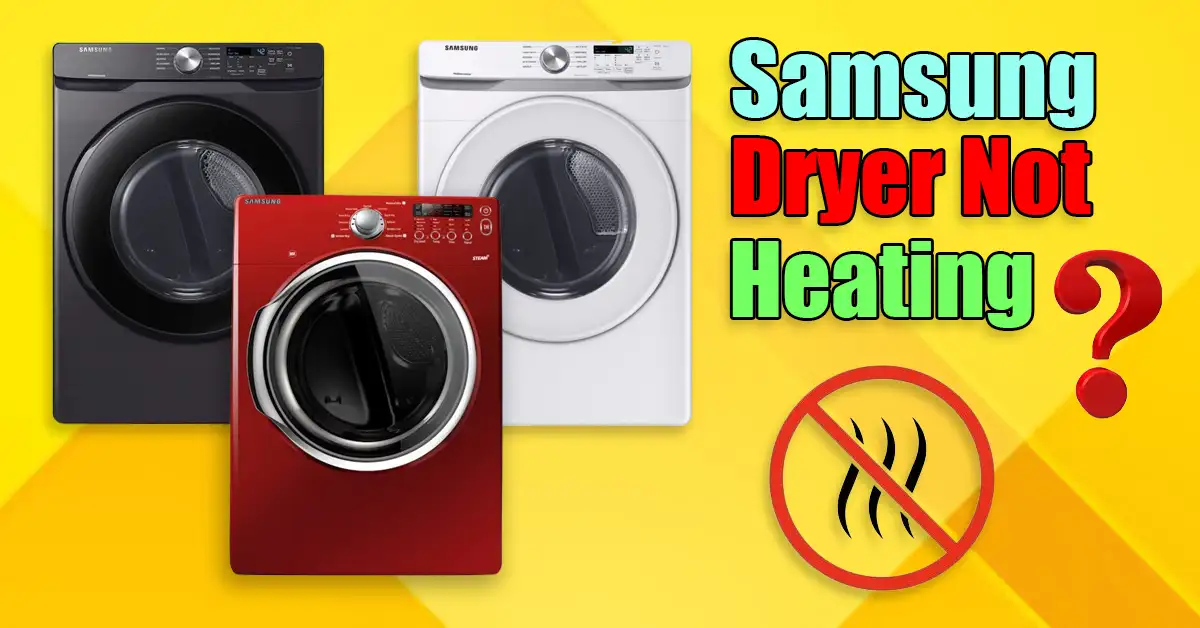Is your Samsung dryer not heating up your clothes? Don’t worry; you’re not alone. As an appliance repair expert, I’ve seen this issue countless times.
Picture this: it’s laundry day, and your dryer should be giving you warm, dry clothes. Instead, you get damp, cold clothes. Frustrating, right? It’s a common problem for many Samsung dryer owners.
In this guide, I’ll walk you through simple steps to get your dryer heating again, from basic checks to more technical fixes like inspecting the heating element and thermal fuse. Whether your Samsung dryer will not heat or the Samsung moisture sensor dryer is not heating, we’ll cover it all.
Table of Contents
Initial Checks for Samsung Dryer Not Heating
Before diving into complex repairs, let’s start with some simple checks. These steps are quick and often solve the issue without much hassle. Trust me, I’ve seen these basic fixes work wonders.

Power Supply
First things first, make sure your dryer is plugged in. It sounds obvious, but you’d be surprised how often this is the problem. Also, check for a tripped circuit breaker or a blown fuse. Once, I had a call where the entire issue was a tripped breaker. A quick reset, and the Samsung dryer not heating problem was solved!
Cleaning
Next, let’s talk about cleaning. A clean lint filter and vent are crucial. They ensure proper airflow, which is vital for heating. Clean them out regularly. I remember a time when a clogged vent was the only thing standing between my client and a fully functioning dryer. Cleaning it out made all the difference. If your Samsung dryer does not heat, this is often the culprit.
Component Inspections for Samsung Dryer Not Heating
Now that we’ve covered the basics, let’s dive into inspecting key components. These parts play a vital role in your dryer’s heating system. If any of these are faulty, your dryer won’t heat properly. Let’s break it down.

Heating Element
The heating element is what warms the air in your dryer. If it’s not working, your clothes won’t dry. To inspect it, you’ll need a multimeter. Check for continuity. If there’s none, the heating element is defective and needs replacing.
Here’s a quick DIY guide:
- Unplug the dryer and open the back panel.
- Locate the heating element and disconnect the wires.
- Test with a multimeter. No continuity means it’s broken.
- Replace with a new heating element, reconnect the wires, and close the panel.
I’ve had to replace a heating element for a client whose Samsung dryer was not heating up. It took about an hour and saved them a lot of frustration.
Thermal Fuse
The thermal fuse is a safety device that stops the dryer from overheating. If it’s blown, the dryer won’t heat. Testing it is similar to the heating element. Use a multimeter to check for continuity. No continuity means the fuse is blown and needs replacing.
Here’s how you can DIY:
- Unplug the dryer and open the back panel.
- Locate the thermal fuse (usually near the blower housing).
- Test with a multimeter. If it’s blown, replace it.
- Reconnect everything and close the panel.
This is a bit more advanced. If you’re not comfortable with DIY repairs, it might be best to call a professional.
In my experience, many issues with a Samsung dryer not heating are due to a blown thermal fuse. It’s a common fix but requires some caution.
Read More: LG vs Samsung Washer and Dryer
Thermostat and Igniter Issues
Now let’s look at some key components that regulate and ignite the heat in your dryer. These parts are crucial for the proper functioning of your dryer, especially in maintaining and starting the heating process.
Cycling Thermostat
The cycling thermostat controls the temperature inside the dryer by turning the heat on and off. This helps to prevent overheating. To test it, you’ll need a multimeter to check for continuity. If it’s faulty, here’s how to replace it:
- Unplug the dryer and open the back panel.
- Locate the cycling thermostat (usually near the blower housing).
- Test with a multimeter. No continuity means it needs replacing.
- Replace the faulty thermostat with a new one.
One time, I had a client whose Samsung dryer was not heating because of a faulty thermostat. Replacing it fixed the issue quickly.
Igniter (Gas Dryers)
In gas dryers, the igniter lights the gas burner to produce heat. If your Samsung gas dryer is not heating, the igniter might be the problem. Here’s how to identify and replace a faulty igniter:
- Unplug the dryer and open the access panel.
- Locate the igniter near the gas burner.
- Check for visible damage or test with a multimeter.
- Replace the igniter if it’s defective.
I once encountered a Samsung dryer not heating up due to a broken igniter. Replacing it was a straightforward fix and got the dryer back to working condition.
Gas Valve Solenoid (Gas Dryers)
The gas valve solenoids control the flow of gas to the burner. If these solenoids are faulty, your dryer won’t heat. Here’s how to test and replace them:
- Unplug the dryer and open the access panel.
- Locate the gas valve solenoids on the gas valve.
- Test with a multimeter for continuity.
- Replace any faulty solenoids.
If your Samsung dryer does not heat and you suspect the gas valve solenoids, testing and replacing them is a good DIY task. However, if you’re unsure, calling a professional is always a good idea.
Additional Components
Now, let’s look at some other parts that might be causing your dryer to lose its heat. These components are often overlooked but play a crucial role in the dryer’s performance.

High-Limit Thermostat
The high-limit thermostat is a safety device. It stops the dryer from overheating. If it’s faulty, your dryer won’t heat. Testing it for continuity will show if it needs replacing. Here’s how:
- Unplug the dryer and open the back panel.
- Find the high-limit thermostat (usually near the heating element).
- Test with a multimeter. No continuity means it’s broken.
- Replace the thermostat with a new one.
I’ve seen many cases where a Samsung dryer does not heat because of a faulty high-limit thermostat. Replacing it is a simple DIY task.
Control Board Issues
The control board is like the brain of your dryer. It sends signals to various parts to work correctly. If it breaks, your dryer might not heat properly. Signs of control board issues include the dryer running but not heating, or the settings not working right. Here’s when to think about replacing it:
- Erratic behavior: If the dryer settings don’t respond correctly.
- No power to heating elements: Even when other parts work.
- Visible damage: Look for burnt areas or damaged circuits.
If you’re not comfortable handling the control board, this job is best for a professional. But knowing the signs can help you decide when to call for help.
I’ve seen control board issues in many dryers, not just Samsung. Once, a client had a Samsung front load dryer not heating due to a bad control board. We replaced it, and the dryer worked great again.
User Settings and Maintenance for Samsung Dryer Not Heating
To keep your Samsung dryer not heating issues at bay, it’s crucial to focus on user settings and regular maintenance. These simple steps can help avoid common problems and extend the life of your appliance.

Temperature and Dryness Settings
Setting the right temperature and dryness level is crucial for efficient drying. If your Samsung dryer is not heating properly, the settings might be incorrect.
- Importance of Correct Settings: The wrong settings can cause your dryer to not heat or dry clothes properly. Make sure to select the appropriate temperature for the type of fabric you’re drying.
- Steps to Adjust Settings:
- Press the “Power” button to turn on the dryer.
- Select the cycle you want to use.
- Adjust the temperature using the “Temp” button.
- Set the dryness level using the “Dry Level” button.
I’ve often found that incorrect settings were the reason a Samsung dryer does not heat. Adjusting these settings can make a big difference.
Load and Ventilation Tips
Properly loading your dryer and ensuring good ventilation are key to its performance.
- Avoid Overloading the Dryer: Overloading can prevent your clothes from drying properly. A full load should fill about three-quarters of the drum. This helps air circulate better and dry your clothes more efficiently.
- Proper Ventilation Setup:
- Check the vent hose for kinks or blockages.
- Ensure the vent is not too long and is as straight as possible.
- Clean the vent regularly to avoid buildup that can cause your Samsung dryer not to heat properly.
Once, I helped a friend who was frustrated because their Samsung dryer was not drying with no heat. Cleaning out the vent solved the problem instantly.
Moisture Sensor Bars
The moisture sensor bars detect the level of moisture in your clothes and adjust the drying time accordingly. Keeping them clean is essential.
- Keeping the Sensor Bars Clean: Residue from dryer sheets and fabric softeners can coat the sensor bars, making them less effective.
- Cleaning Instructions:
- Locate the sensor bars inside the drum.
- Wipe them down with a soft cloth and mild detergent.
- Dry them thoroughly before using the dryer again.
I had a client whose Samsung moisture sensor dryer was not heating properly. Cleaning the sensor bars made a noticeable difference in performance.
By following these user settings and maintenance tips, you can ensure your Samsung dryer works well. Regular care and correct settings can save you time and frustration. This will keep your dryer running smoothly.
Case Study1: Samsung Moisture Sensor Dryer Not Heating
A customer called in with a problem: their Samsung moisture sensor dryer wasn’t heating. The model was a Samsung DV42H5000EW/A3. It’s a popular dryer, but this one wasn’t drying clothes. It was running cycles, but the clothes stayed damp.
Initial Inspection
- Error Codes: The dryer showed error code 9C1. This means a voltage problem.
- Power Supply: The dryer was plugged in, but one of the two circuit breakers wasn’t working. This stopped the dryer from heating.
- Lint Filter and Vent: Both were clogged. This blocks airflow and can stop the dryer from heating.
- Moisture Sensors: They were covered in residue from fabric softeners. This made them give wrong readings.
Steps Taken to Fix the Problem
- Resetting the Circuit Breakers: I reset both circuit breakers. The dryer still didn’t heat, so more problems needed fixing.
- Cleaning the Lint Filter and Vent: I cleaned the lint filter and the vent. Good airflow is important for heating.
- Cleaning the Moisture Sensors: I cleaned the sensors with mild soap and a soft cloth. Clean sensors help the dryer work right.
- Testing the Heating Element and Thermostat: I used a multimeter to check the heating element and thermostat. The heating element was worn out, but the thermostat was fine.
- Replacing the Heating Element: I replaced the faulty heating element. This part makes the heat needed to dry clothes. I disconnected the power, removed the front panel, and changed the part.
Outcome: After these steps, the dryer was put back together and tested. It worked and dried a full load of laundry. I advised the customer to clean the lint filter after every cycle and check the vent and sensors often.
Case Study2: Samsung Front Load Dryer Not Heating
A customer had an issue: their Samsung front-load dryer wasn’t heating. The model was Samsung DV45H7000EW/A2. It was running, but the clothes stayed wet. Here’s how we quickly fixed it.
Initial Check
- Power and Breakers: The dryer was plugged in. One of the two circuit breakers was tripped. Resetting the breaker didn’t fix it, so we moved on.
- Lint Filter: The lint filter was clean. We checked the vent next.
- Vent Blockage: The vent had a large clog. This stops airflow and causes heating problems.
Steps to Fix the Problem
- Clear the Vent: We unplugged the vent hose and cleaned out the lint. Good airflow is crucial.
- Inspect and Clean Moisture Sensors: The moisture sensors had buildup. Cleaning them with soap and water took only a few minutes.
- Check the Heating Element: A quick test showed the heating element was fine but dirty. We cleaned it.
- Replace the Thermostat: The thermostat was malfunctioning, causing the dryer to stop heating. We replaced it.
Outcome: After these steps, the dryer worked perfectly. Clothes came out dry, and the customer was happy. We advised them to clean the vent regularly to prevent problems.
Professional Help
Sometimes, despite our best efforts, fixing a dryer can be tricky. Knowing when to call a professional is important to prevent further damage and ensure safety.
When to Contact a Professional Technician
If you’ve tried all the basic checks and fixes but your Samsung dryer is not heating, it might be time to call in the pros. Here are some signs that you need professional help:
- Persistent Issues: If your dryer still won’t heat after you’ve checked the power, cleaned the vents, and inspected the parts, there may be other issues.
- Complex Repairs: Problems with the control board or wiring should be handled by a professional. These repairs can be tricky and need special tools.
- Safety Concerns: If you’re unsure about handling electrical parts or gas lines, it’s safer to call a technician.
I remember helping a friend with their Samsung gas dryer that wouldn’t heat. They tried everything, but the problem stayed. As an appliance repair expert, I knew it was a tough issue that needed special tools and skills. We called a pro who quickly found and fixed the problem.
Importance of Professional Diagnosis and Repair
Professional technicians have the skills and tools to find and fix problems. Here’s why it’s worth considering:
In my experience, getting professional help for a Samsung dryer that does not heat can make all the difference. It’s worth it for the safety, accuracy, and peace of mind that comes with knowing the job was done right.
Conclusion
We’ve covered the main steps to fix a Samsung dryer not heating. Regular care is key to keeping your dryer running well. By following these tips, you can ensure it works efficiently and avoid common issues.
If you have any questions about your Samsung dryer not heating, just comment below or contact me for more help.
FAQ
Why is my Samsung dryer running but not heating?
If your Samsung dryer is running but not heating, check the power supply, thermal fuse, heating element, and thermostat. Ensure proper ventilation too.
What is the heating error on my Samsung dryer?
The heating error on your Samsung dryer usually indicates a problem with the heating element, thermal fuse, or thermostat. Check these parts to fix it.
How do you reset a dryer that won’t heat?
To reset a dryer that won’t heat, unplug it for 10 minutes, then plug it back in. This can reset the control board.
What is the low heat setting on a Samsung dryer?
The low heat setting on a Samsung dryer is for delicate fabrics, using approximately 120°F to prevent damage and shrinkage, perfect for gentle drying.

